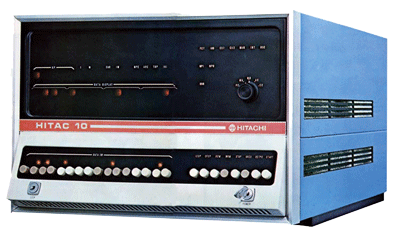

- Home >
- Artifacts of IP Heritage >
- 2008 >
- HITAC 10
HITAC 10

| Manufactured in | 1969 |
|---|---|
| Manufactured by | Hitachi, Ltd. |
| Owner | Division of Advanced Information Technology & Computer Science Institute of Engineering Tokyo University of Agriculture and Technology |
| Location of historical materials | Division of Advanced Information Technology & Computer Science Institute of Engineering Tokyo University of Agriculture and Technology 2-24-16 Naka-cho, Koganei-shi, Tokyo 184-8588, Japan |
| Visitor information | Not open to the public (Ask for a visit) |
| Contact | Division of Advanced Information Technology & Computer Science Institute of Engineering Tokyo University of Agriculture Technology Tel.+81-43-388-7448 https://www.eecs.tuat.ac.jp/ |
The HITAC 10 is the first minicomputer in Japan, which was developed by Hitachi, Ltd. and released in February 1969. It had a 16-bit word architecture. All circuit elements were implemented in ICs, and the magnetic cores were used for the memory unit. The system had the memory capacity ranging from 4K words to at most 32K words. The cycle time was 1.4 milliseconds. the addition/subtraction arithmetic took 2.8 milliseconds. There were 16 basic instructions (up to 12 instructions could be added as an option). It
could be connected to at most 64 input/output devices. The system was equipped with a data typewriter as the basic input/output device, and the paper tapes were used as the portable storage media. The double-precision arithmetic mechanism was used for scientific and engineering computation.
The available software included a monitor (early OS functions), an assembler, compilers (FORTRAN, BASIC), and various input/output subroutines, and it achieved the high efficiency in software development.
The machine was used for a wide range of application due to its distinctive features -- such as compactness, low price, high-reliability, and software productivity. In addition to the personal use in scientific and engineering calculation, it was widely used as a built-in controller for monitoring control, automatic control, production-line control, control of machine tools and robots, drafting/design via plotter control, and data communication control, and instrumentation for gas chromatography, fluorescence analysis, and blood analysis.
It cost ¥4.95 million in the basic configuration with a typewriter.
